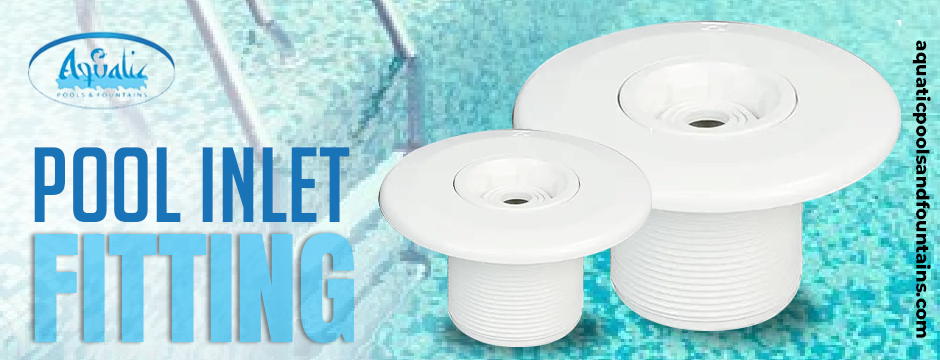In the case of cleaning swimming pools, there are two or three things that come to mind as predominant activities like making the chemical balance in the pool, maintaining the temperature, etc. But one major thing that has always been overlooked by people is the pool inlet fitting. Having a small existence, these tools may not look like a significant thing, but genuinely they have a lot of significance.
In this guidance, we will talk about the importance of this tiny tool on a detailed note.

Pool inlet fittings are also known as the return fittings. These things are generally fixed on the pool walls right after the water level. The main function of these tools is to make the clean water return to the pool after a filtration and heating process.
Circulation
Good circulation is the heart of a well-maintained pool. When water is circulated properly, it ensures that the entire pool gets an even distribution of chemicals and heat. This even distribution prevents “dead spots” where water might become stagnant and where algae and bacteria can grow. The pool inlet fittings help achieve this by directing the flow of water back into the pool in a controlled manner.
Filtration
A Pool inlet fitting works hand in hand with the skimmer and the main drain to help in the filtration process. As water moves through the pool, debris is directed toward the skimmer and the drain, making it easier for the filtration system to catch and remove particles. Without proper circulation, debris can settle in areas that are hard to clean, making your pool dirty.
Heating and Chemical Distribution
If you have a pool heater, inlet fittings help distribute the warm water evenly throughout the pool. The same goes for chemicals; they need to be evenly distributed to maintain a balanced pH and to ensure that all areas of the pool are sanitized. Poor circulation can lead to cold spots and uneven chemical distribution, which can cause discomfort and health issues.
Standard Inlet Fittings
These are the most common types of pool inlet fittings. They usually have adjustable nozzles that allow you to control the direction of the water flow. By adjusting these nozzles, you can direct water to different parts of the pool to ensure even circulation.
Directional Inlet Fittings
Directional fittings provide more precise control over the direction of the water flow. This can be particularly useful in larger pools or pools with unusual shapes where standard fittings might not provide adequate coverage.
Floor Inlet Fittings
These are installed on the pool floor and work alongside wall fittings to improve overall circulation. They are especially beneficial in large pools as they help to circulate water from the bottom up, ensuring that even the deepest parts of the pool receive fresh, clean water.
Now that we understand the importance of a pool inlet fitting, let’s talk about how to optimize them to ensure the best circulation possible.
Placement and Number of Fittings
The placement and number of inlet fittings in your pool play a crucial role in circulation. Typically, a pool should have at least two to three return fittings, but larger pools may require more. These fittings should be strategically placed to ensure even distribution of water. For example, placing them on opposite ends of the pool can help create a circular flow, reducing dead spots.
Adjusting the Nozzles
Once the fittings are installed, adjusting the nozzles correctly is key. The nozzles should be pointed slightly downward and away from the skimmers to promote a circular water flow. This helps push debris towards the skimmer and main drain, enhancing the efficiency of your filtration system.
Regular Maintenance
Regular maintenance of your pool inlet fittings is essential. Check them periodically to ensure they are not clogged with debris and that they are securely attached. Loose or damaged fittings can cause leaks or reduce the efficiency of water circulation. Cleaning the nozzles and the fittings can help maintain optimal water flow.
Using Technology
Modern pools can benefit from advanced technology like variable-speed pumps and automated systems that optimize circulation. These systems can adjust the flow of water based on the pool’s usage and environmental conditions, ensuring that your pool remains clean and well-circulated with minimal manual intervention.
Ignoring the importance of a pool inlet fitting and proper circulation can lead to several problems:
Algae and Bacteria Growth: Poor circulation can create dead spots where water is not adequately sanitized, providing a perfect breeding ground for algae and bacteria.
Uneven Heating and Chemical Distribution: Without proper circulation, some parts of the pool may be colder or have different chemical concentrations, leading to discomfort and potential health risks.
Debris Accumulation: Debris is less likely to be directed towards the skimmer and drain, making your pool dirtier and requiring more frequent cleaning.
At Aquatic Pools and Fountains L.L.C, we pride ourselves on offering top-quality pool equipment to ensure optimal performance and enjoyment for our customers. Our range includes the best multi-flow return inlets designed to enhance pool circulation efficiently. Crafted with precision and durability in mind, our inlets are engineered to provide superior water distribution and maintain a clean, inviting pool environment. With Aquatic Pools and Fountains L.L.C, you can trust that you’re investing in products that prioritize both functionality and quality, delivering the best swimming experience possible. Visit us today to explore our selection and elevate your pool circulation to new heights.
Optimizing pool circulation is not just about maintaining a clean pool; it’s about creating a safe and comfortable environment for swimmers. A Pool inlet fitting is a critical component of this process. By understanding their role and ensuring they are properly placed, adjusted, and maintained, you can significantly improve your pool’s circulation. This, in turn, will make your pool easier to maintain, more enjoyable to use, and extend its lifespan.